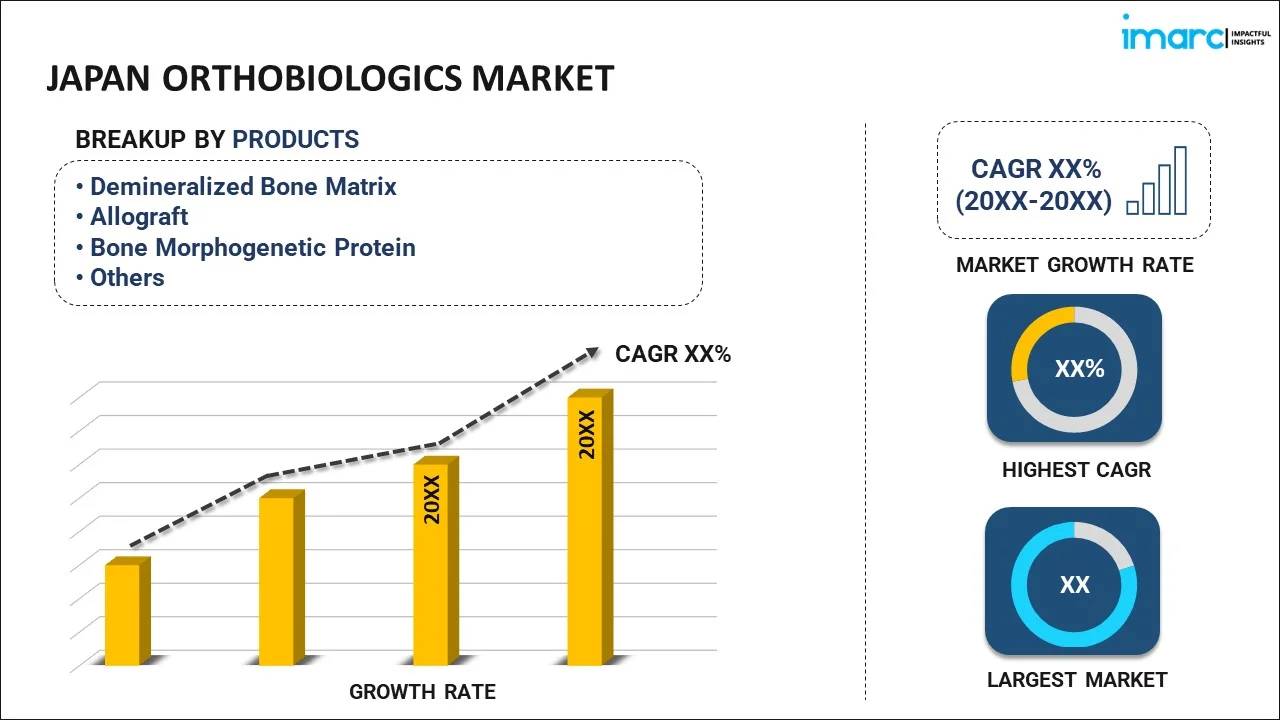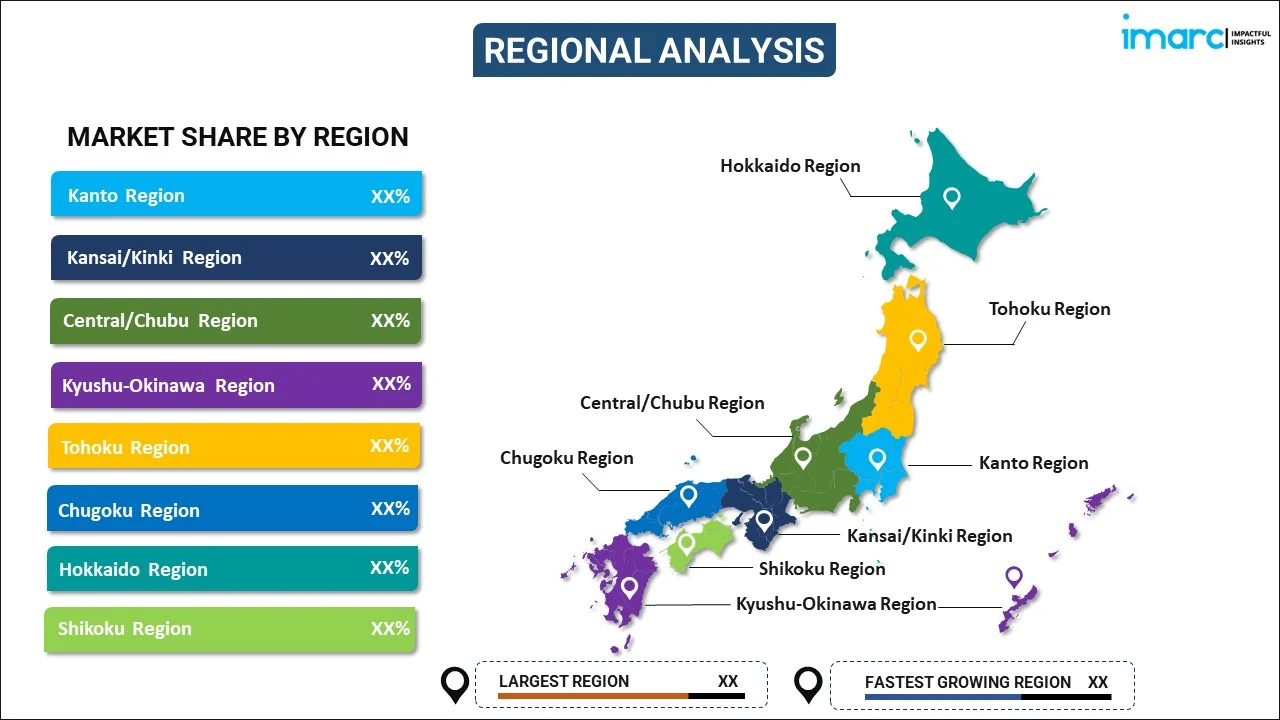
Japan Orthobiologics Market Report by Product (Demineralized Bone Matrix, Allograft, Bone Morphogenetic Protein, Viscosupplementation Products, Synthetic Bone Substitutes, and Others), Type (Knee, Ankle, Hip, Wrist and Shoulder, Spine, and Others), Application (Osteoarthritis and Degenerative Arthritis, Spinal Fusion, Fracture Recovery, Soft Tissue Injuries, Maxillofacial and Dental Applications), End User (Hospitals and Ambulatory Centers, Research and Academic Institutes, Dental Clinics and Facilities, Orthopedic Clinics), and Region 2025-2033
Market Overview:
Japan orthobiologics market size reached USD 283.5 Million in 2024. Looking forward, IMARC Group expects the market to reach USD 508.2 Million by 2033, exhibiting a growth rate (CAGR) of 6.2% during 2025-2033. The growing aging population, who are prone to orthopedic conditions such as osteoarthritis and fracture, on account of several factors, like sedentary lifestyles and obesity, is primarily driving the market.
|
Report Attribute
|
Key Statistics
|
|---|---|
|
Base Year
|
2024 |
|
Forecast Years
|
2025-2033
|
|
Historical Years
|
2019-2024
|
| Market Size in 2024 | USD 283.5 Million |
| Market Forecast in 2033 | USD 508.2 Million |
| Market Growth Rate (2025-2033) | 6.2% |
Orthobiologics is a field of medicine that focuses on using natural substances and biological materials to enhance the body's own healing processes, particularly in orthopedic and musculoskeletal conditions. These therapies aim to stimulate tissue repair and regeneration, reducing the need for more invasive surgical interventions and potentially improving patient outcomes. Common orthobiologics include platelet-rich plasma (PRP), which involves concentrating and injecting a patient's own platelets to promote tissue healing, and stem cell therapy, which utilizes a patient's own stem cells or those from a donor to encourage tissue regeneration. Additionally, there are products like bone grafts and synthetic materials that mimic the properties of natural bone to support fracture healing and spinal fusion. Orthobiologics represent a promising area of research and treatment in orthopedics, with the potential to accelerate recovery, reduce pain, and improve overall function in patients with various musculoskeletal conditions, such as arthritis, tendon injuries, and bone fractures.
Japan Orthobiologics Market Trends:
The orthobiologics market in Japan is experiencing robust growth, primarily driven by a confluence of factors that underscore its promising future. Firstly, an aging population has significantly contributed to the market's expansion. As individuals age, the incidence of musculoskeletal disorders such as osteoarthritis and fractures increases, necessitating orthobiologic treatments that facilitate tissue regeneration and repair. Consequently, the rising geriatric demographic acts as a substantial driving force for the market's growth. Furthermore, technological advancements have played a pivotal role in propelling the orthobiologics market forward. Innovations in biotechnology and regenerative medicine have led to the development of more sophisticated and effective orthobiologic products. This includes the emergence of stem cell therapies, platelet-rich plasma (PRP) treatments, and growth factor-based solutions, all of which offer improved patient outcomes, driving demand for these cutting-edge therapies. Additionally, the emerging application of minimally invasive procedures that offer quicker recovery times, reduced pain, and fewer complications is expected to drive the orthobiologics market in Japan during the forecast period.
Japan Orthobiologics Market Segmentation:
IMARC Group provides an analysis of the key trends in each segment of the market, along with forecasts at the country level for 2025-2033. Our report has categorized the market based on product, type, application, and end user.
Product Insights:

- Demineralized Bone Matrix
- Allograft
- Bone Morphogenetic Protein
- Viscosupplementation Products
- Synthetic Bone Substitutes
- Others
The report has provided a detailed breakup and analysis of the market based on the product. This includes demineralized bone matrix, allograft, bone morphogenetic protein, viscosupplementation products, synthetic bone substitutes, and others.
Type Insights:
- Knee
- Ankle
- Hip
- Wrist and Shoulder
- Spine
- Others
A detailed breakup and analysis of the market based on the type have also been provided in the report. This includes knee, ankle, hip, wrist and shoulder, spine, and others.
Application Insights:
- Osteoarthritis and Degenerative Arthritis
- Spinal Fusion
- Fracture Recovery
- Soft Tissue Injuries
- Maxillofacial and Dental Applications
The report has provided a detailed breakup and analysis of the market based on the application. This includes osteoarthritis and degenerative arthritis, spinal fusion, fracture recovery, soft tissue injuries, and maxillofacial and dental applications.
End User Insights:
- Hospitals and Ambulatory Centers
- Research and Academic Institutes
- Dental Clinics and Facilities
- Orthopedic Clinics
A detailed breakup and analysis of the market based on the end user have also been provided in the report. This includes hospitals and ambulatory centers, research and academic institutes, dental clinics and facilities, and orthopedic clinics.
Regional Insights:

- Kanto Region
- Kansai/Kinki Region
- Central/ Chubu Region
- Kyushu-Okinawa Region
- Tohoku Region
- Chugoku Region
- Hokkaido Region
- Shikoku Region
The report has also provided a comprehensive analysis of all the major regional markets, which include Kanto Region, Kansai/Kinki Region, Central/ Chubu Region, Kyushu-Okinawa Region, Tohoku Region, Chugoku Region, Hokkaido Region, and Shikoku Region.
Competitive Landscape:
The market research report has also provided a comprehensive analysis of the competitive landscape. Competitive analysis such as market structure, key player positioning, top winning strategies, competitive dashboard, and company evaluation quadrant has been covered in the report. Also, detailed profiles of all major companies have been provided.
Japan Orthobiologics Market Report Coverage:
| Report Features | Details |
|---|---|
| Base Year of the Analysis | 2024 |
| Historical Period | 2019-2024 |
| Forecast Period | 2025-2033 |
| Units | Million USD |
| Scope of the Report | Exploration of Historical Trends and Market Outlook, Industry Catalysts and Challenges, Segment-Wise Historical and Future Market Assessment:
|
| Products Covered | Demineralized Bone Matrix, Allograft, Bone Morphogenetic Protein, Viscosupplementation Products, Synthetic Bone Substitutes, Others |
| Types Covered | Knee, Ankle, Hip, Wrist and Shoulder, Spine, Others |
| Applications Covered | Osteoarthritis and Degenerative Arthritis, Spinal Fusion, Fracture Recovery, Soft Tissue Injuries, Maxillofacial and Dental Applications |
| End Users Covered | Hospitals and Ambulatory Centers, Research and Academic Institutes, Dental Clinics and Facilities, Orthopedic Clinics |
| Regions Covered | Kanto Region, Kansai/Kinki Region, Central/ Chubu Region, Kyushu-Okinawa Region, Tohoku Region, Chugoku Region, Hokkaido Region, Shikoku Region |
| Customization Scope | 10% Free Customization |
| Post-Sale Analyst Support | 10-12 Weeks |
| Delivery Format | PDF and Excel through Email (We can also provide the editable version of the report in PPT/Word format on special request) |
Key Questions Answered in This Report:
- How has the Japan orthobiologics market performed so far and how will it perform in the coming years?
- What has been the impact of COVID-19 on the Japan orthobiologics market?
- What is the breakup of the Japan orthobiologics market on the basis of product?
- What is the breakup of the Japan orthobiologics market on the basis of type?
- What is the breakup of the Japan orthobiologics market on the basis of application?
- What is the breakup of the Japan orthobiologics market on the basis of end user?
- What are the various stages in the value chain of the Japan orthobiologics market?
- What are the key driving factors and challenges in the Japan orthobiologics?
- What is the structure of the Japan orthobiologics market and who are the key players?
- What is the degree of competition in the Japan orthobiologics market?
Key Benefits for Stakeholders:
- IMARC’s industry report offers a comprehensive quantitative analysis of various market segments, historical and current market trends, market forecasts, and dynamics of the Japan orthobiologics market from 2019-2033.
- The research report provides the latest information on the market drivers, challenges, and opportunities in the Japan orthobiologics market.
- Porter's five forces analysis assist stakeholders in assessing the impact of new entrants, competitive rivalry, supplier power, buyer power, and the threat of substitution. It helps stakeholders to analyze the level of competition within the Japan orthobiologics industry and its attractiveness.
- Competitive landscape allows stakeholders to understand their competitive environment and provides an insight into the current positions of key players in the market.
Need more help?
- Speak to our experienced analysts for insights on the current market scenarios.
- Include additional segments and countries to customize the report as per your requirement.
- Gain an unparalleled competitive advantage in your domain by understanding how to utilize the report and positively impacting your operations and revenue.
- For further assistance, please connect with our analysts.
 Inquire Before Buying
Inquire Before Buying
 Speak to an Analyst
Speak to an Analyst
 Request Brochure
Request Brochure
 Request Customization
Request Customization




.webp)




.webp)












